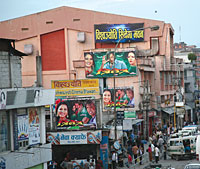 MIN RATNA BAJRACHARYA |
Of the seven Nepali films released in the last two months Hamro Milan Kahile Huncha, Takdir, Jungle Queen, Iku, Takdir and Mission Paisa are reaping good returns while Silsila has crossed 100 days.
The industry has seen a lot of ups and downs since the release of the first Nepali film Aama in 1964. In recent years the market has contracted severely with many cinemas closing down during the conflict while the distribution channels for Nepali films in Darjeeling, Sikkim and Assam have disappeared.
But most film makers are positive that 'Kollywood' is now on the path to recovery.
"We can be hopeful about the industry growing," says Ashok Sharma, president of Nepal Film Producers Association, "While only 28 films were released last year, we can expect the figures to reach 45 this year."
But it is questionable whether a higher volume of releases will equate to higher quality productions. Needless to say, most Nepali films have had repetitive storylines and are highly influenced by Bollywood. Even when a director takes a risk with a new plot, the screenplay and acting is not always up to the mark.
"There is a mass audience that religiously watch Nepali films," says Nakim Uddin, chairman of Quest Entertainment, "and most film makers are satisfied with the returns they get from there." But there is an urban upper class audience that err away from home produced films, opting for Hindi or English movies.
Films that are made to bridge these two audiences end up appealing to only one - or neither - of them. "My film has fared very well outside the valley, although I had expected a better response in Kathmandu where a sector of the audience doesn't really watch Nepali films," says Simosh Sunuwar. maker of Mission Paisa.
But processes are underway to improve the quality of Nepali productions. Digital Cinema Nepal has been actively working on a project to digitalise Nepali films. "Shooting films with digital technology not only gives better quality but also allow us to release the film in many places at the same time," says Sharma.
"There are more young people now who are interested in joining the Nepali film industry. New directors are coming up who are ready to take a risk with different storylines," says Naresh Poudel who is working on his new film Deepshikha after his 2005 hit, Dadkan.
At present, about 150 cinemas operate in the country and efforts are being made to give them a facelift and improve picture and sound quality. Digital Cinema Nepal has digitized 35 movie halls and processes are underway in
10 more.
Although the industry seems to be making headway, film makers are still hesitant about making big investment commitments. The average budget for a Nepali film is Rs 5 million. It rarely crosses Rs 10 million. "The market is limited and so is the return," says Chhabi Ojha, producer of the recent hit Himmat, "if there was a possibility of higher returns, then we would definitely invest more."
Raj Kumar Pokharel, president of Nepal Motion Pictures Association, says that there is an urgent need to revive the lost markets and start exporting Nepali productions abroad. Nepali films should be able to find an audience not only in India but also other countries like Qatar and Malaysia where there is a large Nepali audience. "People will watch the film if it's good," adds Pokharel, "Nepali film makers have to realise that and treat the industry as a commercial undertaking. If we target the right audience with quality films the gains are bound to be higher."


